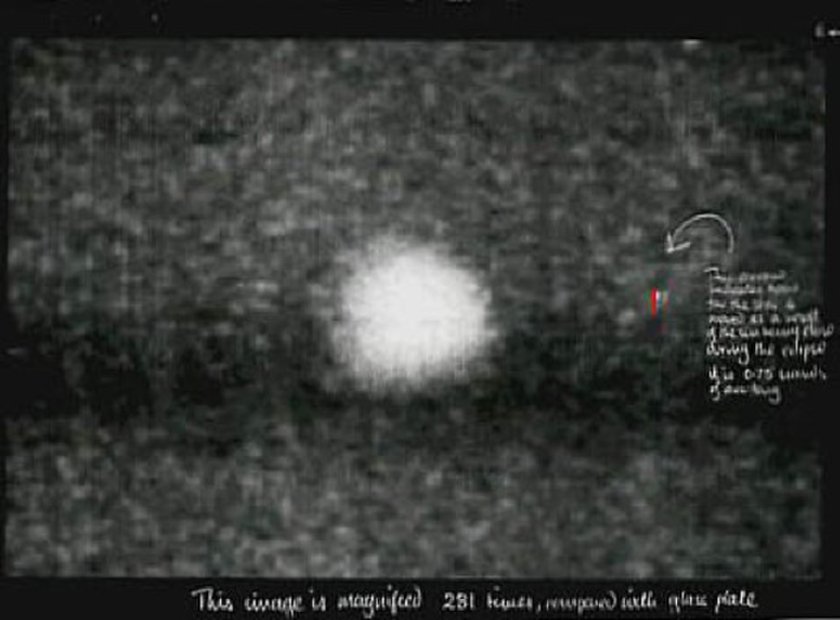Next year will be the anniversary of a rather earth-shattering event. May 29, 2019 will be 100th anniversary of the famed first confirmation of Einstein’s Theory of Relativity.
One of the key tenets of Einstein’s theory is that space-time can be distorted by the motion and mass of objects moving through it. The light from one distant object would appear to bend as it passed near the body of another sufficiently large body on its way to still a third body.
One scientist came up with a way to test this outlandish idea: the effect, although small, might still be measurable not near any body we might encounter on Earth, but on the largest body in our Solar system: the Sun: during an eclipse, and given the right conditions, we might be able to measure the slight change in position of a distant object beyond our solar system consistent with the prediction of Einstein’s theory.

Credit: Royal Observatory, Greenwich
On May 29, 1919, this measurement was successfully accomplished, changing the natural sciences forever. Our conception of the universe was no longer that of a flat, static, unchanging space-time. Within a few decades of this confirmation of Einsteins new theory, the now expanding universe was populated by all sorts of strange new theoretical objects, including black hole singularities where the known laws of the physical universe — including Einstein’s — may no longer hold.
*****
Now, you may ask, what does any of this have to do with Moseley’s book, “Money and Totality”?
Good question.
Einstein’s theory of relativity was the answer to contradictory observations of natural phenomenon for which existing theory could not account. To explain these contradictory observations, Einstein was forced to re-conceptualize space-time itself. This new space-time was no longer flat and unvarying. Gravity, rather than affecting the trajectory of objects, described the shape of the space-time through which objects moved.
Similarly, Marx’s labor theory of value was the answer to persistent contradictions that arise in labor theory of value once prices have to account for the division of socially necessary labor time into the wages of the working class and the profits of capital. Bizarrely, it appears capitalistically produced commodities do not have prices that express their labor values. They have prices of production that no longer directly express the socially necessary labor time required to produce them.
According to Marx’s solution, once the value of labor power was converted into wages, the prices of commodities were converted into capitalistic prices of production, i.e., into the costs of the constant capital and variable capital plus an average rate of profit. The average rate of profit was calculated on the basis of the total social capital and apportioned among individual capitalists as if they were shareholders in a single capitalist firm according to the relative share of their stake.
Contrary to our expectation, division of the social product of the exploitation of the working class takes place not according the relative mass of surplus value squeezed out of the individual work forces of each capital, but by the relative share of capital controlled by each capital in the process of accumulation generally. The manner in which the average rate of profit forms means that even in the case of capitals that employ no labor power and thus create no surplus value they will realize the average rate of profit based on their total mass of employed capital.
Thus, although, ultimately, labor is the only source of profit in the mode of production, empirically it appears each capitalist firm can create its own profit by progressively shedding the costs of wage labor.
This then sets the stage for the self-negation of the capitalist mode of production.
Beautiful statement of Marx’s solution in the last few paragraphs – well done
LikeLike
Thanks.
LikeLike
Hi Jehu,
I am very happy to say that I agree completely with your latest note on my book. My book argues that Marx’s theory explains that profit is produced by the surplus labor of workers in the total economy, even though this conclusion appears to be contradicted at the level of individual industries or individual firms, and even though the purchase of labor-power by wages appears to mean that workers are paid for all their labor and are not exploited.
I think this is the great contribution of Marx’s theory – it reveals the reality of exploitation beneath the surface appearance of an equal exchange between capitalists and workers.
As Marx put it in “Wages, Price, and Profit”: “Scientific truth is always paradox, if judged by everyday experience, which catches only the delusive appearance of things.”
And I certainly hope along with you that Marx’s scientific discovery “sets the stage for the self-negation of capitalism”.
Comradely,
Fred
LikeLike